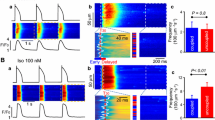Abstract
The ryanodine-sensitive Ca2+ release channel (RyaCRC) of the sarcoplasmic reticulum plays a key role in the intracellular Ca2+ handling in cardiomyocytes. Altered expression of the RyaCRC has been supposed to contribute to abnormal cellular Ca2+ handling and to myocardial dysfunction in dilated and ischemic cardiomyopathy. In the present study the 3H-ryanodine binding site in human myocardial homogenates was characterized and the density of the RyaCRC (which corresponds to the cardiac ryanodine receptor) was determined in nonfailing and in failing human myocardium.
Homogenates were prepared from nonfailing left ventricular myocardium from the hearts of 5 organ donors (NF) and from failing myocardium from 14 explanted hearts of transplant recipients with end-stage heart failure resulting from dilated (DCM, n = 5) or ischemic (ICM, n = 9) cardiomyopathy. Radioligand saturation binding experiments revealed a specific, high-affinity 3H-ryanodine binding site (Kd-values: NF: 0.65±0.11 nmol/l, DCM: 0.66±0.09 nmol/l, ICM: 0.88±0.18 nmol/l; n.s.) in all preparations. Specific 3H-ryanodine binding depended on the free Ca2+ concentration in the assay. It was maximal at 3–100 μmol/l Ca2+. The binding was inhibited by the RyaCRC antagonists ruthenium red (Ki-value: 0.32 [0.18–0.56] μmol/l, n = 5) and Mg2+ (Ki-value: 2.95 [1.23–7.11] mmol/l, n = 5). The RyaCRC density was 103.5±11.9 fmol/mg protein in nonfailing myocardium. There was no significant change in the RyaCRC density in dilated or ischemic cardiomyopathy (112.4±17.1 and 122.7±13.9 fmol/mg protein) compared to nonfailing control myocardium.
In summary, 3H-ryanodine binds specifically and with high-affinity to the RyaCRC in human myocardium. There is no change in the RyaCRC density in failing myocardium of patients with DCM or ICM in comparison to nonfailing controls.
Similar content being viewed by others
References
Arai M, Alpert NR, MacLennan DH, Barton P, Periasamy M (1993) Alterations in sarcoplasmic reticulum gene expression in human heart failure. A possible mechanism for alterations in systolic and diastolic properties of the failing myocardium. Circ Res 72:463–469
Beuckelmann DJ, Näbauer M, Erdmann E (1992) Intracellular calcium handling in isolated ventricular myocytes from patients with terminal heart failure. Circulation 85:1046–1055
Bradford MM (1975) A rapid and sensitive method for the quantitation of microgram quantities of protein utilizing the principle of protein-dye binding. Anal Biochem 72:248–254
Brillantes AM, Allen P, Takahashi T, Izumo S, Marks AR (1992) Differences in cardiac calcium release channel (ryanodine receptor) expression in myocardium from patients with end-stage heart failure caused by ischemic versus dilated cardiomyopathy. Circ Res 71:18–26
Cheng YC, Prusoff WH (1973) Relationship between the inhibition constant (Ki) and the concentration of inhibitor which causes 50 per cent inhibition (I50) of an enzymatic reaction. Biochem Pharmacol 22:3099–3108
Chu A, Diaz-Munoz M, Hawkes MJ, Brush K, Hamilton SL (1990) Ryanodine as a probe for the functional state of the skeletal muscle sarcoplasmic reticulum calcium release channel. Mol Pharmacol 37:735–741
Coronado R, Morrissette J, Sukhareva M, Vaughan DM (1994) Structure and function of ryanodine receptors. Am J Physiol 266:C1485-C1504
D'Agnolo A, Luciani GB, Mazzucco A, Gallucci V, Salviati G (1992) Contractile properties and Ca2+ release activity of the sarcoplasmic reticulum in dilated cardiomyopathy. Circulation 85:518–525
Fabiato A (1988) Computer programs for calculating total from specified free or free from specified total ionic concentrations in aqueous solutions containing multiple metals and ligands. Methods Enzymol 157:378–417
Fabiato A, Fabiato F (1978) Calcium-induced release of calcium from the sarcoplasmic reticulum of skinned cells from adult human, dog, cat, rabbit, and frog hearts and from fetal and newborn rat ventricles. Ann NY Acad Sci 307:491–522
Gwathmey JK, Slawsky MT, Hajjar RJ, Briggs GM, Morgan JP (1990) Role of intracellular calcium handling in force-intervall relationships of human ventricular myocardium. J Clin Invest 85:1599–1613
Harigaya S, Schwartz A (1969) Rate of calcium binding and uptake in normal animal and failing human cardiac muscle. Membrane vesicles (relaxing system) and mitochondria. Circ Res 25:781–794
Holmberg SRM, Williams AJ (1989) Single channel recordings from human cardiac sarcoplasmic reticulum. Circ Res 65:1445–1449
Holmberg SRM, Williams AJ (1990) The cardiac sarcoplasmic reticulum calcium-release channel: modulation of ryanodine binding and single-channel activity. Biochim Biophys Acta 1022:187–193
Lachnit WG, Phillips M, Gayman KJ, Pessah IN (1994) Ryanodine and dihydropyridine binding patterns and ryanodine receptor mRNA levels in myopathic hamster heart. Am J Physiol 267:H1205-H1213
McGrew SG, Wolleben C, Siegl P, Inui M, Fleischer S (1989) Positive cooperativity of ryanodine binding to the calcium release channel of sarcoplasmic reticulum from heart and skeletal muscle. Biochemistry 28:1686–1691
Meissner G (1994) Ryanodine receptor/Ca2+ release channels and their regulation by endogenous effectors. Ann Rev Physiol 56:485–508
Movsesian MA, Bristow MR, Krall J (1989) Ca2+ uptake by cardiac sarcoplasmic reticulum from patients with idiopathic dilated cardiomyopathy. Circ Res 65:1141–1144
Movsesian MA, Karimi M, Green K, Jones LR (1994) Ca2+-transporting aTPase, phospholamban, and calsequestrin levels in nonfailing and failing human myocardium. Circulation 90:653–657
Naudin V, Olivicro P, Rannou F, Sainte Beuve C, Charlemagne D (1991) The density of ryanodine receptors decreases with pressure overload-induced rat cardiac hypertrophy. FEBS Lett 285:135–138
Sapp JL, Howlett SE (1994) Density of ryanodine receptors is increased in sarcoplasmic reticulum from prehypertrophic cardiomyopathic hamster heart. J Mol Cell Cardiol 26:325–334
Zucchi R, Ronca-Testoni S, Gongyuan Y, Galbani P, Ronca G, Mariani M (1994) Effect of ischemia and reperfusion on cardiac ryanodine receptors — sarcoplasmic reticulum Ca2+ channels. Circ Res 74:271–280
Author information
Authors and Affiliations
Rights and permissions
About this article
Cite this article
Schumacher, C., Königs, B., Sigmund, M. et al. The ryanodine binding sarcoplasmic reticulum calcium release channel in nonfailing and in failing human myocardium. Naunyn-Schmiedeberg's Arch Pharmacol 353, 80–85 (1995). https://doi.org/10.1007/BF00168919
Received:
Accepted:
Issue Date:
DOI: https://doi.org/10.1007/BF00168919




